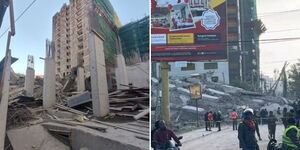The National Environment Management Authority (NEMA) has demolished several buildings in Nairobi including the Southend Mall which stood on riparian land.
A riparian area simply refers to the region of land bordering any natural channel or depression in which water flows regularly or intermittently such as the banks of rivers and streams.
The riparian land stretches to a minimum of 6 metres up to a maximum of 30 metres on either side of the watercourse banks from the highest water level according to the Survey Act of 1989, and Water Quality Regulations (2006) and Water Resources Management Rules (2007).
[caption caption="Demolition of SouthEnd Mall on Langata Road"] [/caption]
[/caption]
This distance is based on the width of the river and the water volume at any given time.
The Survey Act further prescribes setback distance for oceans as 60 meters. Riparian land plays a crucial role as a buffer zone for wetlands in terms of preventing soil erosion, and other causes of degradation.
The Water Act 2016 defines riparian habitat as "the dynamic complex of plant, animal and micro-organism communities and their non-living environment adjacent to and associated with a watercourse".
According to this Act, the Water and Sanitation Cabinet Secretary (CS) is required to formulate a National Water Resource Strategy through public participation every five years and submit an assessment report annually on the same.
The strategy, among other things, outlines "measures for the protection, conservation, control and management of water resources and approved land use for the riparian area".
The character and condition of the riparian habitat hence are as important as the in-stream habitat in conserving the quality of the water resource and supporting the ecosystem.
Encroachment of the riparian lands in Nairobi by private developers does not only obstruct the watercourses but also poses risk to the sustenance of the riparian ecosystem.
Riparian areas, which are also a key component of wetlands, are considered unsafe for construction due to the underground water systems that may weaken the foundations making the buildings potentially dangerous.
A March 2011 order issued by NEMA directing those encroaching into wetlands and adjacent riparian land to vacate noted that wetlands also include swamps, springs, dams, rivers, lakes, deltas, estuaries, mangroves among others.
[caption caption="Uncontrolled encroachment and exploitation of riparian land in Nairobi"] [/caption]
[/caption]
"Wetlands are important as they provide ecological services including sieving up aquatic pollutants, acting as biodiversity habitat, recharging underground water systems and help mitigating floods by regulating storm-water flow over time and increase water retention.
"The areas also aid in climate change adaptation as they support flora and fauna, recharge aquifers during the dry season, help in nutrient retention and shoreline stabilization," the order by NEMA concludes.

16-Storey Building Collapses in Nairobi News Just In











